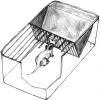Simple behavioral assessment of mouse olfaction
- PMID: 19575474
- PMCID: PMC2753229
- DOI: 10.1002/0471142301.ns0824s48
Simple behavioral assessment of mouse olfaction
Abstract
This unit presents two basic protocols that offer rapid assessments of anosmia (the absence of a sense of smell) in mice. The buried food test is used to check for the ability to smell volatile odors. The olfactory habituation/dishabituation test is used to test whether the animal can detect and differentiate different odors, including both nonsocial and social odors. A non-contact method of odor presentation, along with a general method for collecting urine samples, is given as an alternate protocol. The tests described in this unit only require simple equipment and can be adopted readily by most laboratories.
Copyright 2009 by John Wiley & Sons, Inc.
Figures



References
-
- Achiraman S, Archunan G. 1-Iodo-2methylundecane, a putative estrus-specific urinary chemo-signal of female mouse (Mus musculus) Theriogenology. 2006;66:1913–1920. - PubMed
-
- Alberts JR, Galef BG., Jr Acute anosmia in the rat: a behavioral test of a peripherally-induced olfactory deficit. Physiology & behavior. 1971;6:619–621. - PubMed
-
- Brennan PA, Keverne EB. Something in the air? New insights into mammalian pheromones. Curr Biol. 2004;14:R81–89. - PubMed
-
- Brennan PA, Zufall F. Pheromonal communication in vertebrates. Nature. 2006;444:308–315. - PubMed
MeSH terms
Grants and funding
LinkOut - more resources
Full Text Sources
Other Literature Sources

